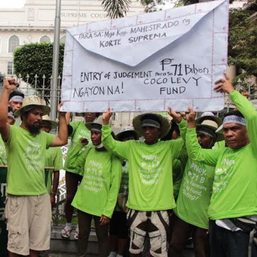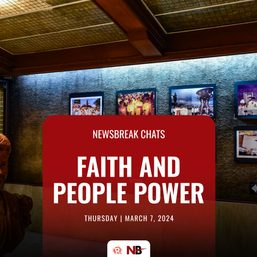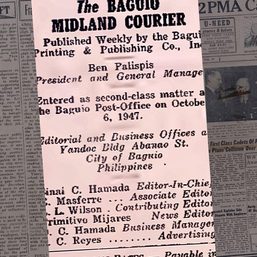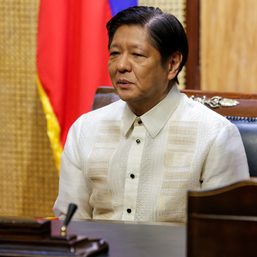SUMMARY
This is AI generated summarization, which may have errors. For context, always refer to the full article.
![[OPINION] What happened to laughter in February 1986?](https://www.rappler.com/tachyon/2024/02/tl-laughter-1986.jpg)
Commemorating the EDSA People Power Revolution has become more mind-numbing – not just because the post-Marcos regimes had routinized it but also because in celebrating (or condemning) it, the loyalists and the yellows, the gaunt Enrile and the aging Jesuits at Loyola Heights emphasize its solemnity (yes, even the Marcos derision of EDSA has this bizarre somberness, perhaps to hide their lies) and forget how much laughter there was in those three days and four nights.
Those of us who were there in February 1986 heard anger, passion, and protests, but also so much hilarity. But these merry instances never made it to the history books, as the serious and the miraculous took the central stage. And so, perhaps 38 years later, and before our memory gets addled, it might be worth recalling some of these funny moments which, I would argue, played a significant role in the ouster of the lupus-scarred dictator and his odious family.
Ligorio G.M. Naval of the Middle East Production Federation of Manila enjoined Filipinos to “thank the almighty God for the transformation of our nation into a free Philippines where we can now enjoy absolute freedom and democracy.” But he surely could not miss the “young fans [who] were screaming at the sight of Ricky Davao, Jay Ilagan, Gina Alajar, and Amy Austria together, [and] a family [that] had apportioned and roped off several square feet of the road from the traffic island with a makeshift shelter, stool, a large cooler, and charcoal stove.” Because movie screenwriter Amado Lacuesta did, remembering how he saw “young people…waving their banners and laughing and cheering and flashing the L-sign, [and] one of them brandish[ing] a home-made placard: ‘Subok sa Krisis, takot kay Mrs.’” Lacuesta could only shake his head, adding, “This isn’t revolution. It’s fiesta, only more fun.”
Tricycle “operator” Joselito Carriaga enjoyed being there: “At first, I was scared, especially when I saw those tanks coming and people trying to stop them with flowers and prayers…Oh, I enjoyed it, too, since food was given free…you could get food for free any time. That I liked very much.”His neighbors had fun with Alfonso R. Flores, a vendor, when he and his family announced they were going to EDSA: “On our way to Crame, a lot of people cheered us on. Some said we were heroes without medals, while others said we would never come back alive. They said they were staying to clean the chapel so that it would be ready for our wake.”
Delfin Quiambao, a utility man, was recruited to participate in Malacanang’s pro-Marcos crowd. He remembered that “Marcos called the loyalists and said he was going to give jobs [and] 100 pesos to those who would come to Malacanang. I just went there to eat. While he was saying it was good of us to come, someone announced that the food was already there. The 500 people there ran to where the food was, and nobody was left to listen to Marcos.”
Even the G&D were amused
Even the grim and determined leftists were amused. The late film director Behn Cervantes was so into the “heat of battle” around the Channel 4 area but also noticed a side story unfolding that was so unlike what the middle class and the elite were so seriously into in the area as they tried to “seize” the government television building.
There is shooting going on, but there is also incessant chatting and commentaries being given by the people around the place. A housemaid comes out of a house and stands for all to see, including the snipers on top of that tower, that she isn’t afraid. An older man clucks his tongue and says, “Talaga naman, o?” An urchin picks up the cue and screams at the girl, “Hoy, gusto mo ba mabaril, ha? [Hey, do you want to get shot?]” She gives him and the rest a look of disdain and walks back behind the walls of their house. More wisecracks follow and you remember a statement made many times over that Filipinos are not serious revolutionaries. They chat and joke during marches. They make little picnics out of rallies. They are even fashionably dressed for the occasion. Not like
Cervantes’ fellow director, Lino Brocka, also chimed in. As he watched pro-Aquino and Marcos loyalists confront each other in Malacañang Palace, an embarrassed Brocka was shocked at how Pinoys combined levity and street battles:
Manay, nakakahiya bang sabihin, di mo yata maaalis sa Pinoy, sa gitna ng batuhan at stampede, tuwing may camera lights, tigil kami, kuntodo luhod ‘yung mga nasa harap para ‘wag matakpan ang mga nasa likod, sabay ngisi at L sign! Pa- picture! Kuha yung mga nakatingala. Kuha yong nasa tabi ng tangke. Cut to cut na ganyan. Tapos, ayan, umuulan na naman ang mga bato, putok ang ulo ng iba, duguan, ang gulo!
Communing on the streets was not quite precisely mutually affirming. People were indeed physically closer, but the class divide remained intact. Rose Marie Arenas, the rumored mistress of General Fidel Ramos, expressed surprise when she “saw how poor the people were who lived inside those small iskinitas,” but also how they were “all so hospitable; they offered us drinks, they even invited us to stay overnight.” A Makati matron who went to EDSA with her Christian Dior bag found herself linking arms with a stranger and confessed that her “big concern was: I am going to die with this man, and I don’t know his name.”
Rolando Domingo was stunned as he watched two people “hurrying away with a valuable-looking frame, a man in sandals [holding [ a box of vegetables high over his head, [a]] group. Hastily bundling up what looked like dresses or curtains, [and a] man..hiding a handful of M-16 magazine clips under his jacket. Soldiers were around, but they made no move to stop the looters. They just milled around in a daze. I left early. Of my vigils, this at Malacañang was the shortest—and the most shocking.” Mob rule worried singer Leah Navarro as she and her friends snapped at someone who suggested that the best way to stop the assault of Marcos loyalist troops was to make Molotov cocktails. Even the ordinarily peaceful nun was peeved, and she “almost boxed his ears.”
Dare to Marcos loyalists
Yet, it turned out the masses were as capable as the middle class and elite in looking at EDSA ’86 in moral terms. It was not only the burgis who were ready to die to prevent the tanks; the poor, too. Repairman Antonio Sordilla made this dare to Marcos loyalists
Go on, kill me! Don’t you know who’s paying you? We’re paying our taxes so that you’ll have a salary. Now, what are you doing? You’re fighting us. Go on. Fight with your fellow soldiers! Go on, kill each other! We were chanting ‘Laban’…We said to ourselves, ‘Let it be. This happens only once.’ Fear did not enter my mind then. I was ready to die for our country. I was concerned about our children. They are growing up. We are educating them for our country so that they’ll be able to run the country in the future. Marcos should step down now. That was what I was thinking about…We are Filipinos, not strangers, not foreigners – so why should our own soldiers kill us?
Other “ordinary” Pinoys were angry for the same moral reasons. Jose Malacruz, a janitor in Malacañang, witnessed the looting and wrote, “I saw an old woman cursing while holding the portrait of Mrs. Marcos. Later, she tore it up. I saw tears in her eyes.” Rosemarie Osita, an office employee, “saw papers and documents scattered all over the palace. Some were throwing them through the windows. I saw people looting phones and other office equipment – anything they could carry.” Osita paused, then added: “In a way, it was a shame that people would do it, but also it was understandable because of the feelings against the First Couple and family.”
Even communist supporters fell for Jaime Cardinal Sin’s spell. In a statement that would probably shock his political officer, the watch technician Ernesto Ancheta prided himself on being at EDSA every night, “providing whatever help I could give. The reason I went to was that I heard Butz Aquino calling for help, so I went. I am a BAYAN follower, so I went. I believe Butz Aquino. Later, priests and nuns joined us.” Ancheta was a member of the CPP’s legal coalition but now believed in an “anti-Marcos reactionary” (Aquino) and celebrated mass with diehard conservatives (priests and nuns).
So, if the masa were as equally serious as the other classes in EDSA, why is there a propensity to highlight their frivolousness? Why is there anxiety towards those having fun on the streets?
Pushed to the margins
Stuart-Santiago has the most plausible answer. She noticed that as the night wore on, [The] crowd had lost its middle-class character and was now diluted with legions of workers, squatter area residents, and urban poor – the great unwashed. Although there was some resentment at their presence, they could not be driven away. They provided the mass necessary to keep the rebellion’s leadership viable.” Lacuesta confirmed Santiago’s observations: “Far away at the corner of Santolan Road, a huge red and black flag spanned the southbound lane of EDSA…The dominant color was bright yellow, but sinister reds or combinations of red and black also abounded, along with a sprinkling of white and other colors and combinations. The word “anarchy” came to mind, but I preferred to be more positive and thought of “people power” instead. Still, it aroused more hope than conviction.”
As the balance of power tilted towards the EDSA 1986 revolutionaries, the masses’ voices were being pushed to the margins. At Channel 4, the “powers that be” had “decided no lefties should go on [television]” and blamed them for all that had happened. Lyca Benitez-Brown whined, “if the lefties had not started protesting against Marcos, we probably would never have got to EDSA.” Balladeer Freddie Aguilar was angry when pro-Marcos artists were invited to join the “rebel network” and became more incensed when his airtime was curtailed and people shooed away by management. He called at the latter “mga burgis…mga porma.” There was little he could do.
Aguilar’s and Cervantes’ exclusion also marked the point where the middle class and elite interpretations of EDSA assumed pre-eminence, becoming the conventional and ironically popular narrative when Cory Aquino was sworn in as president. It is quite true that in these public recollections, the voices of ordinary Filipinos are put into print, but the remembrances of the Alta Sociedad outnumbered them. The latter was surprised at the propensity of the “great unwashed” to turn coups into carnivals and how their innocence fell prey to Marcosian and communist manipulations.
The icing on the cake of elite and middle class sneering at people experiencing poverty was what the businesswoman-columnist and food brigade head Elvira Pelaez-Marfori told EDSA chronicler Patricio Mamot. She returned to the highway the day after Marcos left and was shocked: “Ang baho dito, ang panghi. The “place of revolution the morning after: ‘It’s a dump!’” That same morning, however, the “Metro Aides,” a group Imelda Marcos created to clean Metropolitan Manila’s surroundings, did heed the new Governor’s order and cleaned the area with nuns, priests, and seminarians. There is no evidence that Marfori joined in the cleaning.
The perfect foil to Pelaez-Marfori was Ramon Diaz, a distributor of cleaning machine helped, and when asked why he helped the Metro Aides clean, he replied: “Once you’ve learned to work with others to bring about what you want, it’s hard to stop.” The solidarity persisted even after the Fall of Marcos, although it would not last long. But at that moment, it was there, and as Diaz wonderfully put it, “it’s hard to stop.”
It takes a woman
The subversion by laughter would continue even a year after EDSA. In January 1987, 300 pro-Marcos soldiers seized the Channel 7 television station and occupied it for two days. After realizing that no reinforcements would be coming, the rebel leader, Colonel Oscar Canlas, demanded to talk to General Fidel Ramos. In the meantime, negotiators were trying to figure out Canlas’ vulnerabilities and agreed that – much like what her sister did to General Balbas of the Marines at EDSA 1986 – they would weaken Canlas’ resolve by bringing in his wife to plead that he surrender.
An hour or two later, a unit was brought to the site, Mrs. Canlas, who was given a megaphone to tell her “Oscar” to surrender. But as soon as Mrs. Canlas began to call out to her husband, another woman with a megaphone was entreating “Oscar” to give up. Then, for one moment, everyone – the two women, the officers and their men, journalists, and the many usyosos like us – froze, stepped back, looked at both women, and realized that the stern Canlas had been living a double life. Once the shock wore off, the two Mrs. Canlas immediately started going after each other, claiming in their loud voices (note their megaphones were still on) that she was the legitimate spouse and the other was just the kabit. As their screaming became louder, so did our laughter. By the time the combat team assigned to each Mrs. Canlas was able to move them at a safe distance, everyone was cracking up and doubling in their stomachs. The next day, Colonel Canlas and his men surrendered.
It is, of course, challenging to make a causal connection between the gaiety and Canlas’ subsequent capitulation. However, it is also not far-fetched to suggest that after he was exposed to the entire country as a philanderer, a babaero, the colonel’s claim that their “rebellion” was prompted by the alleged injustices of the Aquino government also went down the drain very, very fast. We went back to UP that afternoon, not so pleased that Cory Aquino survived another coup but delighted that we could watch a sideshow that was Pinoy na Pinoy!
Finally, there was my EDSA ’86 experience. As I read Angela Stuart’s fine manuscript on EDSA Uno and EDSA Dos, I found myself transported back in time to Santolan Road, in the early morning of 24th February 1986, the second day of the stand-off between a million people acting as a buffer between a bunch of failed coup plotters and the Marines sent in by the ailing dictator Ferdinand Marcos to eliminate them.
In that narrow street, a handful of us remained to man the barricades. The rest of that million had gone home to the comforts of their beds. We stayed because our dormitory bunks were uncomfortable; there was free food and drinks!
By early morning, our shabby defensive perimeter had dwindled to about twenty people who drifted in and out of sleep as we sought to maintain our position. Suddenly, we awakened to the distinctive smell of tear gas. Through the morning haze, we began to make out a phalanx of Marines with bayonets fixed on their Armalite rifles, slowly marching towards us. Their boots created this ominous crunch that echoed through the street, bouncing off the walls, telling us to prepare to meet our fate.
As they drew closer, we found no mercy in their eyes. Some were grinning. Exhausted and on edge, the Marines had had enough of this “people’s power.” Many had been flown straight from the jungles of southwestern Mindanao. They wanted an end to this business, intending to break through our line and kill if necessary to clear the way for a more significant force to bring down the failed coup plotters. Then, they could get their much-deserved sleep.
‘Make kapit-bisig’
Those of us from UP – veterans of street battles against the police and military in places like Mendiola Bridge, Avenida Rizal, and Quezon Boulevard – immediately sensed our disadvantage. Yet we knew we had to slow the Marines’ advance long enough to allow runners to alert the rebels and disperse the crowd milling around the front of the camps, protecting both from a major assault by the Marcos forces. After putting up a good fight, we would beat a hasty retreat, carrying our wounded and shouting back at the pasistas that we would come better prepared the next time.
We started collecting whatever stones and wooden planks we could find in the street, but our pitiful weapons procurement was cut short when a group of colegialas rushed from behind. In tears – the gas canisters were taking their noxious effect – they pleaded that we do not fight but also not retreat. Joining our files to “make kapit bisig,” they declared that “for Cory and our democracy,” we should stand and shower the Marines with love and prayers, enjoining them to cease their attack to join us, the people.
We were stunned: here were those konyo UP kids who would not give us unwashed Narra Residence Hall dormers the time of day. Here were the same people who would probably order their chauffeurs to toss us spare change if their luxury sedans stopped beside us, thinking we were pulubi. To the political hardliners among us (and there were some jaded ones), these were the folks who would be shot first once the communists’ national democratic revolution triumphs.
But in the charged atmosphere of that early morning on 24 February 1986, class hatred dissolved in the name of popular unity, and even the most embittered proletariat found solidarity with the pretty bourgeoisie. A martyr’s death would be: the stones were thrown aside, and the pamalo abandoned. We Quiapo-bred and Tondo-raised UP kids, the probinsiyano, stood next to our new perfumed comrades, prepared to use “goodness” and “Godliness” to convince the Marines that slicing our guts with bayonets would not be good for the country.
The boots advanced, echoing in the streets. A UP fratman volunteered to lead the Our Father, surprising those of us who knew him as a die-hard atheist. By the time praying began, the Marines were only a couple of feet away. Perhaps our consuelo de bobo would be leaving this earth wrapped in the arms of Manila’s beautiful Golden Ghetto coeds. Who would go to Heaven and who would go to Hell would be anybody’s guess.
Then the crunching stopped, and we saw the Marines turn around and retreat. Much later, we learned that General Fidel Ramos had tricked the Marine commander into believing that Marcos had flown the coop. With the Commander-in-Chief abandoning them, there was no more reason for the Marines to complete the mission order. The teargas dissipated, the weary Marines withdrew, and the colegialas disappeared with the same haste as they had interjected themselves in our midst. Minutes later, our defensive perimeter evaporated after we learned that a complimentary breakfast of pan de sal and eggs was being served nearby.”
Where does all remembering lead us? In his book Taming People’s Power, Lisandro Claudio examined the contesting accounts over how EDSA ’86 was being remembered. The book, however, looks at these opposing views post facto (or shall we say after the event).
EDSA’s funny asides had these dual, contrasting functions. On the one hand, they gave us a glimpse of what was happening on the wayside with the “ordinary Pinoys,” and these included words and actions that would not be sanctioned by the victors but which was the solidarity-making and creative laughter that is at the center of any popular uprising. On the other hand, by attributing hilarity to the masa, those who seized the narrative sought to trivialize that same laughter, turning it into a sideshow littered with petty anecdotes.
All these redactions, trivializing, and revisionisms were already at play even as “the crowd” protecting failed coup plotters dreaming of a revolutionary junta eyeballed the Marines at EDSA during those four days that changed the direction of our politics. – Rappler.com
Sources cited: Monina Allarye Mercado. 1987. The Greatest Democracy Ever Told – People Power: An Eyewitness History. Manila. New Society Publication. Angela Stuart-Santiago. 2013. EDSA Uno: Narrative and Analysis with Notes on Dos and Tres. Mandaluyong. Pulang Lupa Foundation.
Patricio N. Abinales teaches at the University of Hawaii-Manoa but intends to retire and go home one of these days.
1 comment
How does this make you feel?
![[Newspoint] A fighting presence](https://www.rappler.com/tachyon/2024/07/thought-leaders-a-fighting-presence.jpg?resize=257%2C257&crop=441px%2C0px%2C1080px%2C1080px)
![[Closer Look] ‘Join Marcos, avert Duterte’ and the danger of expediency](https://www.rappler.com/tachyon/2024/06/TL-trillanes-duterte-expediency-june-29-2024.jpg?resize=257%2C257&crop_strategy=attention)




![[OPINION] Raised on radio](https://www.rappler.com/tachyon/2024/04/raised-on-radio.jpg?resize=257%2C257&crop=396px%2C0px%2C720px%2C720px)
![[Just Saying] Marcos: A flat response, a missed opportunity](https://www.rappler.com/tachyon/2024/04/tl-marcos-flat-response-april-16-2024.jpg?resize=257%2C257&crop=277px%2C0px%2C720px%2C720px)


![[Free to Disagree] Boomers, let go please](https://www.rappler.com/tachyon/2024/07/tl-boomers-let-go.jpg?resize=257%2C257&crop=286px%2C0px%2C720px%2C720px)


![[ANALYSIS] The political divorce rocking the Philippines](https://www.rappler.com/tachyon/2024/07/TL-duterte-marcos-china-US-feud-july-4-2024.png?resize=257%2C257&crop=303px%2C0px%2C720px%2C720px)

Thanks to Patricio Abinales for his amusing article. It is amusing to know about a first-hand account of “those four days that changed the direction of our politics.” Having participated in EDSA 1, we can count on him as one of those EDSA 1 heroes whose participation was essential in its success. I’m hoping he will come home someday and retire here. He might be needed for the last EDSA in his lifetime.